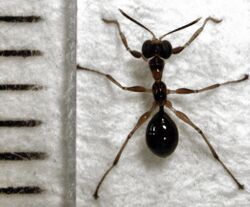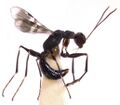Biology:Dryinidae
| Dryinidae | |
|---|---|

| |
| Gonatopus alpinus female | |
| Scientific classification | |
| Domain: | Eukaryota |
| Kingdom: | Animalia |
| Phylum: | Arthropoda |
| Class: | Insecta |
| Order: | Hymenoptera |
| Superfamily: | Chrysidoidea |
| Family: | Dryinidae Haliday, 1833 |
| Subfamilies | |
|
Anteoninae | |
Dryinidae is a cosmopolitan family of solitary wasps. Its name comes from the Greek drys for oak: Latreille named the type genus Dryinus because the first species was collected in an oak plant in Spain. The larvae are parasitoids of the nymphs and adults of Auchenorrhyncha.[1] Dryinidae comprises approximately 1900 described species, distributed in 17 subfamilies and 53 genera.[2][3][4]
Description
The adult wasp can measure from 0.9 to 5.0 mm in length and in some cases can reach 13 mm.[5] The body of the adult wasp has a 'waist' where it is constricted in the middle. The rear legs have spurs which may be used for grooming. The antennae have 10 segments. Many species have a marked sexual dimorphism, where males are totally different from the females in the size and shape of the body.[2][6] Males have wings while females are often wingless and resemble worker ants. The ovipositor is retractable and not visible when retracted.
Life history
The female dryinid injects an egg into the host insect with her ovipositor. Females may also have front legs modified with a pinching apparatus which they use to restrain the hosts for their larvae during oviposition. The larvae are legless or have only vestigial legs. The larva feeds on the internal structures of the host, and as it grows larger it begins to protrude from the body. It develops a hardened sac (called a "thylacium") around its body for protection. The host is eventually killed and the larva leaves the dead body and spins a cocoon.[7]
Gallery
Issus coleoptratus nymph with dryinid larva under right wing
See also
References
- ↑ Guglielmino, A.; Olmi, M.; Bückle, C. (2013). "An updated host-parasite catalogue of world Dryinidae (Hymenoptera: Chrysidoidea)". Zootaxa 3740 (1): 1–113. doi:10.11646/zootaxa.3740.1.1. PMID 25112881.
- ↑ 2.0 2.1 Olmi, M.; Virla, E.G. (2014). "Dryinidae of the Neotropical region (Hymenoptera: Chrysidoidea)". Zootaxa 3792 (1): 1–534. doi:10.11646/zootaxa.3792.2.1. PMID 24869997.
- ↑ Olmi, M.; Xu, Z. (2015). "Dryinidae of the Eastern Palaearctic region (Hymenoptera: Chrysidoidea)". Zootaxa 3996 (1): 1–253. doi:10.11646/zootaxa.3996.1.1. PMID 26250320.
- ↑ Martins, A.L; Lara, R.I.R.; Perioto, N. W.; Olmi, M. (2015). "Two new species of Dryinidae (Hymenoptera: Chrysidoidea) from areas of Atlantic Rainforest at São Paulo State, Brazil". Brazilian Journal of Biology 75 (2): 455–9. doi:10.1590/1519-6984.19613. PMID 26132032.
- ↑ Olmi, M.; Virla, E.G. (2006). "35. Familia Dryinidae". in Fernández, F.; Sharkey, M. J.. Introducción a los Hymenoptera de La Región Neotropical. Bogotá: Sociedad Colombiana de Entomologia y Universidad Nacional de Colombia. pp. 401–418.
- ↑ Olmi, M. (1994). The Dryinidae and Embolemidae (Hymenoptera: Chrysidoidea) of Fennoscandia and Denmark. Fauna Entomologica Scandinavica. 30. Brill. pp. 1–100. ISBN 978-90-04-10224-8.
- ↑ Dryinidae. Identification of Principal Groups of Insects. Discoveries in Natural History & Exploration. UC Riverside.
External links
Wikidata ☰ Q202880 entry
 |





